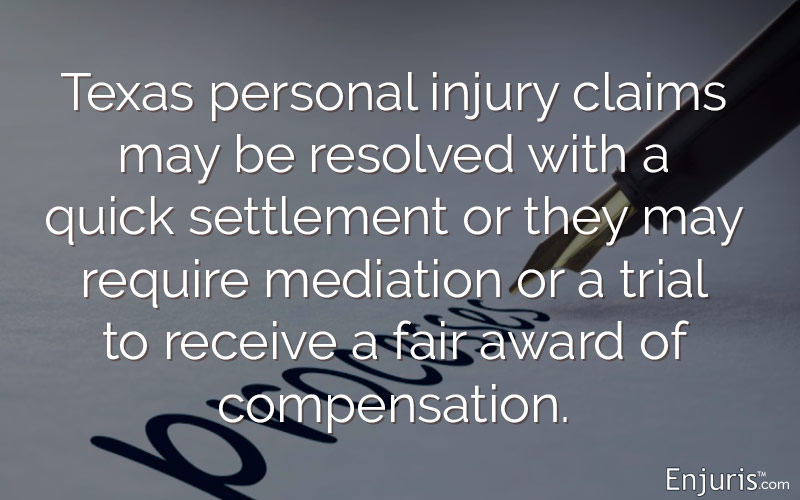Hablamos español.
Here's what lies ahead if you want to make a personal injury claim in Texas
The basic process for personal injury cases will apply across all states. However, some elements may vary for Texas, including the time limit within which you must bring your case against an offending party.
Steps of the Injury Claim Process in Texas
- Selecting an attorney
- Fact finding
- Settlement or filing suit
- Final decision
If you are a Texas resident and wish to pursue a personal injury case, it’s a good idea to read up on the injury claim process for Texas as soon as possible. (See our resources for Texas accident victims.)
Here we’ll walk you through the basic steps and what to expect.
Let’s get started!
Step 1: Selecting your Texas accident attorney
The injury claim process in Texas starts with your phone call. You have to make the first move by letting a personal injury lawyer know the circumstances of your accident.
Choosing an accident attorney who knows Texas law is important, because laws can vary by state – and by accident type - and using a lawyer who is knowledgeable of the specific laws that apply will be to your advantage.
We recommend you set up consultations with a few different Texas lawyers specializing in your type of accident or injury.
Preparing for the consultation
The consultation with a Texas accident lawyer will be typically a 30-60 minute long meeting. The purpose of the meeting is to gather details about your accident and determine whether you will be comfortable working with the attorney.
You should bring any supporting documents that you have. Examples of supporting documents are police reports, medical bills, X-rays, pictures, videos, etc.
The attorney will review your information and listen to your story. At the end of the consultation, the attorney will let you know if he or she can represent you.
See our guide to Preparing to Meet with a Personal Injury Attorney and interview checklist.
Paying your attorney: how it works in Texas
The attorney will also let you know the terms of the representation, and then you can decide whether those conditions suit you.
Your attorney may offer contingency representation, which is worry-free representation until your case closes. A personal injury attorney usually will receive a percentage of your settlement if you win the case. You will not pay a penny to most attorneys if you lose the case.
Most personal injury law offices work this way because they know that their clients are suffering from an enormous financial disadvantage.
What percentage do lawyers take for personal injury? Generally somewhere between 25-40% is the norm. This may be negotiable.
Contingency representation has many benefits, including mental, physical and financial peace at a time that’s already difficult for you.
Another advantage is that it motivates your attorney – which is great for you, too!
Step 2: Fact finding
Your new law firm will begin proceedings once you sign an agreement to accept their representation.
They will go a bit deeper with their own investigations. The attorneys may speak to people who were involved in the incident during this stage. The attorney may talk to eyewitnesses, law enforcement officers, doctors, employers, photography and video specialists, radiologists and more. They will review all documentation they are able to collect.
The purpose of the additional investigation is to gather as much information as possible so that the attorney is clear on the percentage of fault and a compensation request.
At this stage, which can take several months, the attorney is still evaluating whether you have a case as well as the value of that case.
Texas uses fault percentage in its personal injury claims.
Fault percentage means the judge considers the percentage for which you were responsible for the incident.
Your settlement will be reduced by the percentage that you were at fault. For example, in Texas you would only receive $100,000 if you were 50% at fault in a $200,000 case.
You may be eligible for compensation as long as you are under 51% at fault for your incident. Texas practices what is called, “contributory negligence” and follows the bar-51 rule. Where a Plaintiff is 51% or more at fault, the Plaintiff may be barred from receiving an award.
Step 3: Settlement or filing suit
Your attorney will notify the defendant of your claim and may attempt to reach a settlement agreement.
Depending on the details of the claim, a Texas attorney, as in other states, may first try to settle the case out of court to protect your interests. This may be especially attractive if you are struggling and cannot work or pay your bills because of your accident. They will try to negotiate an out-of-court settlement that will make everyone happy.
A settlement will allow you to have the funds you need to get back on your feet. It will allow the attorneys to get their fair share, and it will allow the offender to escape media exposure and public scrutiny. Many offenders agree to settle for that reason.
If you do not reach a settlement at this point and your attorney advises to file a suit in a Texas court, you will usually have another opportunity to reach a settlement.
In certain situations, it is a better choice to file a suit and take the personal injury claim to court.
If your attorney advises that your case should be taken to court, the first step is your attorney filing a summons against the offender. Your Texas attorney will know where to file the necessary documents. You have a right to receive the full hand of your attorney’s representation.
The formal complaint will reiterate your monetary, physical and emotional losses to the courts and to the defendant. The defendant will then have a certain amount of time to respond.
Step 4: The discovery process
In Texas as in other states, the discovery process is when the attorneys for both sides bring forth all of the necessary facts and supporting documentation.
The discovery process can last for months or years.
Keep in mind that after your case has been filed, the statute of limitations becomes tolled. This means that your case is filed and because it is filed, the time limit to file your case stops.
Then as the discovery phase draws to a close, the lawyers will begin discussions and negotiations to attempt to reach a settlement.
Step 5: The final decision
If a settlement cannot be reached, mediation provides another means by which to reach agreement without going to trial. A mediator will bring both attorneys and their clients together to overcome a stalemate.
Mediation
The mediator functions as a communication link between your attorney and the other attorney in order to encourage the settlement process. (Keep in mind that the mediator’s role is limited. The mediator is unable to order a settlement and the mediator is not a judge.)
Generally mediation is quicker, cheaper and less stressful than the next stage.
Arbitration
If mediation does not prove fruitful, arbitration can be acquired. If a judge orders an arbitration hearing, or if your attorney and the other attorney agree to an arbitration hearing, arbitration may be the next step.
The arbitrator is either a retired judge or attorney. They will adhere to the law. Furthermore, the arbitrator not only acts as a mediator in the settlement process, they also have the power to order and enforce a settlement when both parties agree.
An arbitration proceeding functions like a loose judicial hearing. Witnesses can be called by either party. Either party can bring all the evidence they can. Certain rules, such as hearsay, for example, can be eased. In a sense, an arbitration is like a conversation between lawyers and a judge without the strict formalities of a courtroom.
Trial
If mediation and/or arbitration fail and settlement is unreachable by both parties, the final step is to go to trial. Once your case is scheduled for trial, you will be dependent on the timing of the Texas courts. Trial dates may be planned and then rescheduled.
At the trial, the judge decides whether you win your case and how much money you will receive as compensation.
However, if a jury trial had been demanded and acquired, it is usually the jury that decides compensation.
Keep in mind there are certain instances where the amount of compensation that can be awarded is capped by law. See Texas Damage Caps – How Much Can You Sue for in Texas?
If you’re a resident of Texas, don’t wait to start the personal injury claim process.
Many people are surprised at how long it can take before they receive compensation.
Read more in our Texas personal injury guide and get in touch with one of our friends of Enjuris personal injury attorneys in Texas today.
See our guide Choosing a personal injury attorney.



